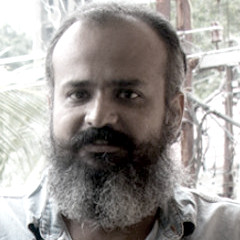'Malaikottai Vaaliban': LJP's folklore is Madhu Neelakandan's cinematography masterclass

Mail This Article
'Malaikottai Vaaliban' is Lijo Jose Pellissery narrating a folktale with all its rustic beauty. The narrative begins with the classic storytelling approach: "Once upon a time, there lived a mallan (wrestler)." Each time Pellissery delves into Malaikottai Vaaliban's encounters with his nemesis, the tale magnifies, remaining true to tradition. As the fantasy reaches its zenith, where the protagonist attains a mythical stature, we willingly suspend disbelief. By this point, Pellissery has adeptly conditioned the audience to believe that Vaaliban can indeed perform such incredible feats.
As the promotional interviews maintained, ‘Malaikottai Vaaliban’ transcends the confines of genre, region, and era – much like the stories we heard from our grandparents. Those bedtime tales often painted a vivid picture of the protagonist, their adversaries, and the monumental challenges they faced, paying little attention to the setting. Whether the stage was a fort hidden within a jungle or one nestled in a desert, the focus remained steadfastly on the characters. Perhaps that's why Lijo selected the desolate landscapes of Rajasthan as the backdrop for ‘Malaikottai Vaaliban’. On this blank canvas, he meticulously crafted his characters, infusing them with action and emotion. Or maybe it is simply his ode to Western Films and the greatest storytellers of that genre. Regardless, it offers a visual feast for theatregoers.
While purists of Lijo Jose Pellissery's work and Mohanlal's fans might not deem ‘Malaikottai Vaaliban’ their magnum opus, it will undoubtedly be remembered for the brilliance of Madhu Neelakandan behind the camera, Danish Sait's portrayal of Chamathakan, Hareesh Peradi's performance as Ayyanar, Prashant Pillai's musical composition, Gokul Das's production design, and Deepu S Joseph's editing. However, it is Lijo's storytelling and Mohanlal's effortless acting that truly convince the audience of Vaaliban's capabilities.
When Arnold Schwarzenegger's character prepares for the last stand against the creature in the 1987 'Predator,' it is his extraordinary physique that convinces the audience that this mortal could have a chance against the extraterrestrial hunter. Vaaliban, on the other hand, does not possess a towering physical presence. Yet, when Lijo conveys that he can bundle up a wrestler with his shawl and toss him into the air, we readily accept it. Vaaliban flexes his biceps a few times on screen, but these moments do not define his prowess. Instead, it is his facial expressions, particularly his eyes, that reveal the source of his strength. Lijo crafts numerous cinematic moments, but one of the most striking occurs when Vaaliban holds off a charging platoon with an iron grill to buy time for his friends. As his companions escape through a door, Vaaliban alone stands, gripping the grill. It appears the soldiers may overwhelm him, but the legendary warrior arches backwards, his eyes reconnecting with the source of his power. He then pushes the grill back, causing the entire platoon to tumble backwards. Madhu's camera returns to Vaaliban's face, and the intensity emanates through the lens, making us believe that this beast of a man can accomplish such feats.

Madhu Neelakandan is at his finest in Malaikottai. Whenever Lijo gave him a blank canvas, he masterfully filled those expansive frames with a minimalist approach. Irrespective of day or night, he creates layers of emptiness in frames, each with its intensity, carefully situating Lijo's characters as the narrative demands. And when Lijo brought chaos to the table, he drew the most complex of mandalas with colours and patterns using hundreds of actors and props. His lighting, whether under the moonlit plains or within the claustrophobic corridors of forts illuminated by oil lamps, is impeccable. His characters walk in and out of shadows and lights, and the camera follows them like a moth to the flame. Madhu dictates where the moonlight will end on his frame and from where the shadows will grow only to be diluted by the flickering warmth of light spilling from an oil lamp or a campfire.

Lijo's colour-coding in ‘Malaikottai Vaaliban’ adds an intriguing dimension. When Vaaliban's combat is primarily physical, colours are gradually introduced until they culminate in red and black. The first encounter with the mallan unfolds against the backdrop of a rustic village, with the characters dressed in off-white dhotis. The second battle takes place in a maroon-coloured tent, with his opponent wearing darker attire. Upon reaching Malakottai to confront Lord and Lady Macaulay (Andrea Ravera and Diana Nasanova), the colour scheme shifts to a blend of black and red. However, when Vaaliban faces a group of treacherous adversaries driven by jealousy, the dominant colour becomes yellow. Once the plot of deception thickens, Vaaliban is seen lost amongst a sea of masked people. His enemies are all shown wearing Chamathan's attire and like a 'rattlesnake' ready to strike, they crawl around him. Chamathakan's hyena-like laughter pierces through Vaaliban's defences. He loses his dear ones.

If 'Malaikottai Vaaliban' is Madhu Neelakandan's MasterClass for cinematographers, then it is Mohanlal's display of how to weave a body suit with acting. Lijo Jose Pellissery, in turn, showcases how to expertly craft and convey a fantasy narrative on the silver screen.


